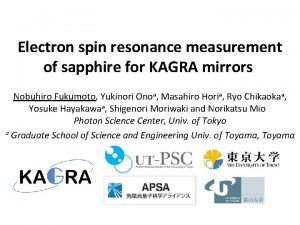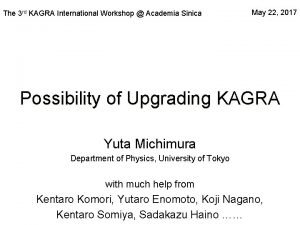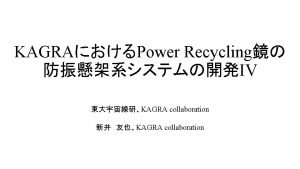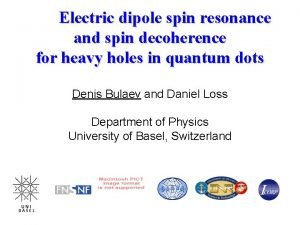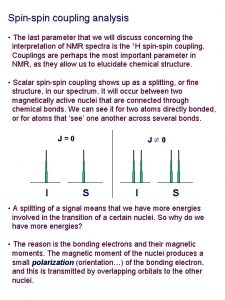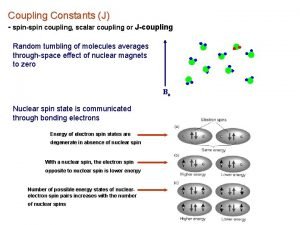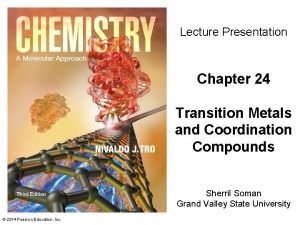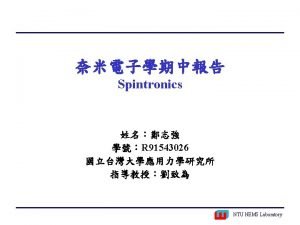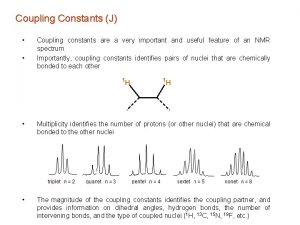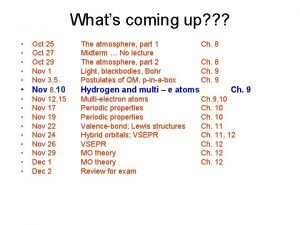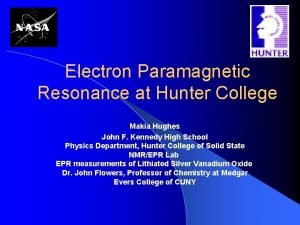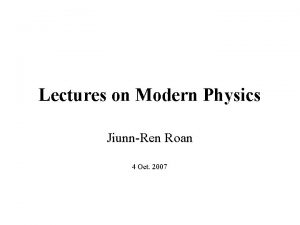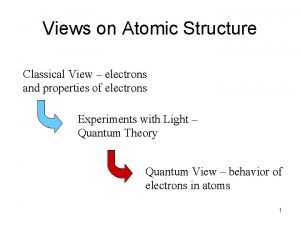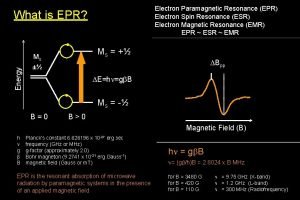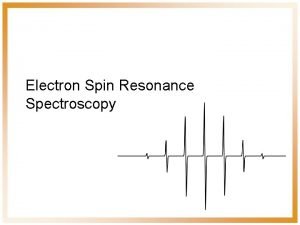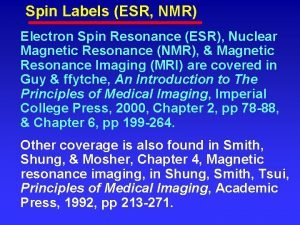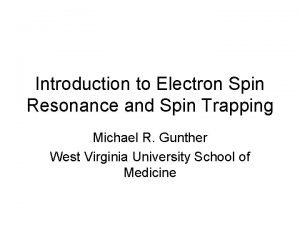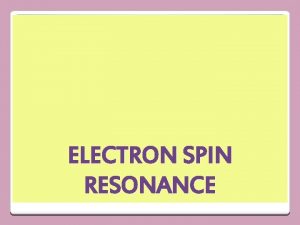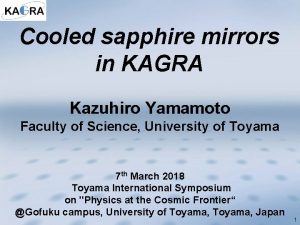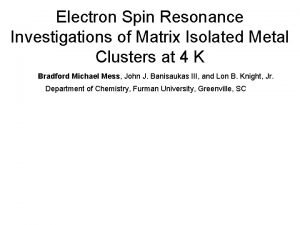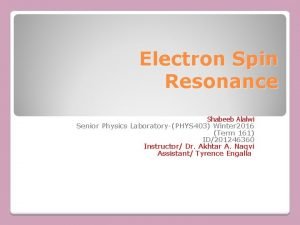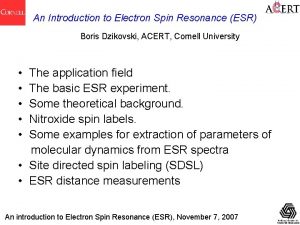Electron spin resonance measurement of sapphire for KAGRA


















- Slides: 18

Electron spin resonance measurement of sapphire for KAGRA mirrors Nobuhiro Fukumoto, Yukinori Onoa, Masahiro Horia, Ryo Chikaokaa, Yosuke Hayakawaa, Shigenori Moriwaki and Norikatsu Mio Photon Science Center, Univ. of Tokyo a Graduate School of Science and Engineering Univ. of Toyama, Toyama

Japanese gravitational wave detection project KAGRA Gravitational wave Propagating as space strain Strain is very small No evidence of direct observation Gravitational wave interferometer space strain(plus mode) Huge Michelson interferometer Efforts for decreasing noises ・ mono-crystal sapphire mirror KAGRA interferometer Sapphire mirror 2

Mono-crystal sapphire mirror Demerit Merit ・low mechanical loss (lower at cryogenic measurement) ・high thermal conductivity ・IR (infrared) absorption By impurities (Fe 3+ , Cr 3+ , Ti 3+ …) Sample IR absorption → 30~680 ppm /cm KAGRA requirement → 50 ppm /cm We need information about impurities in Mono-crystal sapphire 3

Electron Spin Resonance(ESR) Energy level transition (Free Electron) 4

Electron Spin Resonance(ESR) Setup ・Cavity Excite standing microwave ・Electromagnet Sweep external field Standing microwave fields Inside of cavity 5 High sensitive measurement observing each spin

Instruments Setup ESR measurement instruments ( Graduate School of Science and Engineering Univ. of Toyama , Ono. lab) microwave frequency: 9. 38 GHz(X-band) Sweeping magnetic Field: 0~ 10 k. G ESR instrument Electromagnet and cavity 6

Sample preparation Crystals for IR absorption measurement High IR absorption crystal(680 ppm/cm): AC 150 Low IR absorption crystal (30 ppm/cm): P 401 Cut samples for ESR measurement Cut into 27 blocks(from A 1 to C 9) C-axis IR absorption crystal diameter: 10 mm length: 40 mm Sample cutting 7

Measurement Summary We have measured 27 x 2=54 samples. Measurement condition Temperature: room temperature Microwave power: 1 m. W Microwave frequency: 9. 38 GHz ESR peak summary ESR peaks at 3 regions around 2 k. G around 3 k. G around 5 k. G Comparison of peaks between samples among blocks 8

Intensity(a. u. ) Around 2 k. G P 401_A 8 AC 150_A 3 Peak 1705 G Peak 1930 G Field(G) Each peak position is different→ different origin 9

Around 3 k. G Intensity(a. u. ) Peak: 3345 G P 401_A 8 AC 150_A 3 Peak: 3345 G Field(G) Peak at the same position 10

Around 3 k. G, another block Intensity(a. u. ) P 401_C 8 AC 150_C 3 Field(G) No peak→ depend on position 11

Intensity(a. u. ) Around 5 k. G P 401_A 1 AC 150_A 3 Peak: 5233 G Field(G) Only high absorption sample has peak →possibility of contribution to IR absorption 12

Peak intensity distribution around 3 k. G AC 150 P 401 A B C A Peak intensity distribution diagram B C Red: High Yellow: Middle Blue: Low Intensity is largest at red part and decreases with distance→possibility of local impurity/affix in cutting 13

Identification of impurity Fe 3+ 3+ Cr 3+ Ti Conversion peak position (calculated from g-value) High Low Both (b): RT 9. 50 GHz RT R. S. de BIAS 1 and D. C. S. RODRIGUES J. Am. Cerum. Soc. , 68 [7] 409 (1985) Radiation Measurements 43 (2008) 295 – 299 Around C 1 high IR absorption sample has Around F 3, C 2, both samples has peak , but Around Ti 3+and peak, samples have peak, but, these 3+ no peak, but it Fe has around F 1 around andsame F 2, C 2 they has nopeak. peaks are as case. 14

Summary We observed ESR signals of the samples fabricated from the mono-crystals of different IR absorptions. We observed peaks with intensity dependence on the block position around 3 k. G. It may come from local impurity or affix in cutting. We observed peaks from only high IR absorption crystal sample around 5 k. G. It can be related to IR absorption. 15

Future work We have not identified the impurity yet. In order to do so, we will prepare mono-crystal samples in which impurities (Fe 3+, Ti 3+ Cr 3+…) are intentionally doped and measure them for impurity identification. 16

Thank you for your attention 17

18
 Electron spin resonance takes in
Electron spin resonance takes in Kagra international workshop
Kagra international workshop Kagra
Kagra Electric dipole spin resonance
Electric dipole spin resonance Spin spin coupling
Spin spin coupling J coupling constant
J coupling constant What is a low spin complex
What is a low spin complex 優點
優點 J coupling constant
J coupling constant Electron delocalization and resonance
Electron delocalization and resonance Electron spin
Electron spin Electron spin
Electron spin Electron spin
Electron spin Electron spin
Electron spin Atom jj thomson
Atom jj thomson Electron spin
Electron spin Electron spin
Electron spin Larmor precession animation
Larmor precession animation Sapphire mohs hardness scale
Sapphire mohs hardness scale
